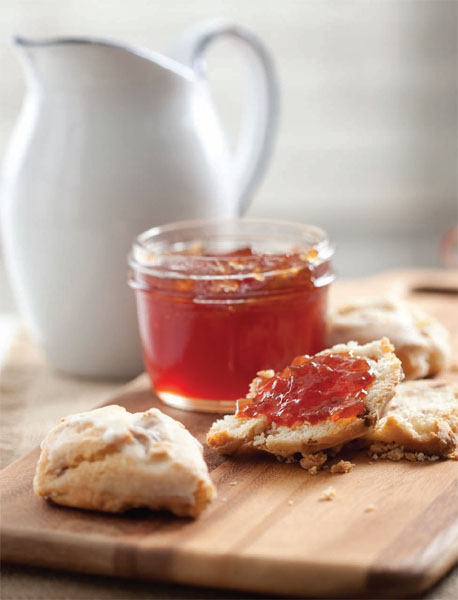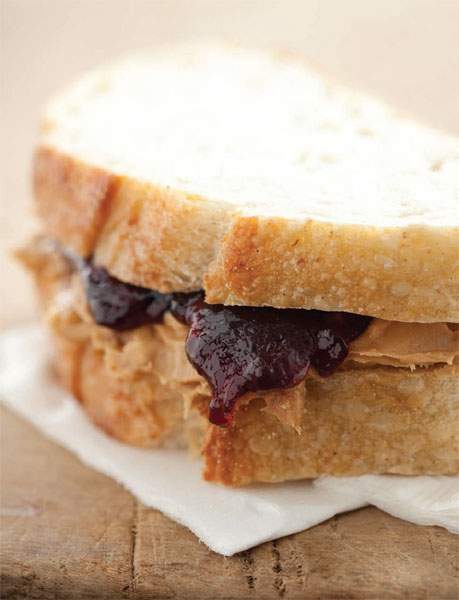Authors: Marisa McClellan
Food in Jars (11 page)
5 pounds/2.3 kg quince
4 cups/800 grams granulated sugar
â
cup freshly squeezed lemon juice
Core the quince and chop it into rough cubes. Combine quince pieces with 3 quarts/2.8 liters of water in a large stock pot set over high heat. Bring the water to a boil, reduce the heat to medium, and simmer for 2 to 3 hours, until the fruit and liquid turn a deep pink color. The liquid should have reduced by approximately half and the chunks of quince should be very soft when crushed with the back of a wooden spoon. When it's done, strain the juice from the pulp using a fine mesh sieve or jelly bag, taking care not to pressure or squeeze the quince pulp. Forcing liquid from the pulp will make your jelly cloudy. Let pulp drain for 3 to 4 hours, reserving the juice.
Prepare a boiling water bath and 4 half-pint/250 ml jars according to the process on page 10. Place the lids in a small saucepan, cover them with water, and simmer over very low heat.
In a large, nonreactive pot, combine 5 cups/1.2 liters of the reserved quince juice, sugar, and lemon juice and bring them to a boil over high heat. Cook, stirring frequently, for 15 to 25 minutes, until the volume in the pot is greatly reduced. Clip a candy thermometer to the pot and stir occasionally until the jelly reaches 220°F/105°C. It should look thick, with the bubbles like molten lava.
When the jelly has reached 220°F/105°C, pour it into the prepared jars. Wipe the rims, apply the lids and rings, and process in a boiling water bath for 10 minutes (see
page 11
).


T
SINCE MOVING TO THE EAST COAST, RHUBARB HAS
become my personal indicator that spring is finally on the way. When it arrives, I buy it by the armload and make butters, jams, compotes, and this ruby-colored jelly. It tastes tart and clean, just as a new season should.
1½ pounds/680 g rhubarb, chopped
3 cups/600 g granulated sugar
1 (1.75 ounce/50 g) packet powdered pectin
Combine the chopped rhubarb and 3 cups/720 ml water in a pot. Cover and simmer for 20 to 25 minutes, or until the rhubarb has completely broken down and the water is tinted a vivid pink.
Line a large, fine-mesh sieve with cheesecloth and place it over a large bowl. Pour the cooked rhubarb through. Let it sit and drip for at least 30 minutes. Do not press the rhubarb pulp, as that will make your jelly cloudy. Discard the solids in the sieve and measure out 4 cups/960 ml of rhubarb juice.
Prepare a boiling water bath and 4 half-pint/250 ml jars according to the process on page 10. Place the lids in a small saucepan, cover them with water, and simmer over very low heat.
Measure the sugar into a bowl. Whisk the powdered pectin into the sugar to blend.
In a large, nonreactive pot, combine the rhubarb juice and the pectin-spiked sugar.
Bring to a boil and cook over high heat for 15 to 25 minutes, stirring frequently, until the volume in the pot is greatly reduced. While you continue to stir, clip a candy thermometer to the pot and watch until the pot reaches 220°F/105°C. There will be a great deal of foaming and bubbling before it reaches this point. It should look thick and syrupy and the bubbles should look glossy.
Test the set of the jelly using the saucer test described on page 77. If it doesn't pass, return the pot to the heat and cook for an additional 5 minutes before repeating the test.
When the jelly has reached the desired consistency, pour it into the prepared jars. Wipe the rims, apply the lids and rings, and process in a boiling water bath for 10 minutes (see
page 11
).

T
HIS JELLY TASTES LIKE A SPREADABLE VERSION
of autumn. It reminds me of pumpkin patches, the night before Thanksgiving, and the pomander balls we used to make as kids, all spice and fragrance. After you use it on peanut butter sandwiches and morning toast, try it melted down and brushed on roast chicken or tofu.
3 cups/600 g granulated sugar
1 (1.75 ounce/50 g packet) powdered pectin
4 cups/960 ml fresh pressed apple cider
Zest of 1 orange
2 teaspoons ground cinnamon
1 teaspoon ground ginger
½ teaspoon freshly grated nutmeg
½ teaspoon ground cloves
Prepare a boiling water bath and 4 half-pint/250 ml jars according to the process on page 10. Place the lids in a small saucepan, cover them with water, and simmer over very low heat.
Measure the sugar into a bowl. Whisk the powdered pectin into the sugar to blend.
In a large, nonreactive pot, combine the apple cider and the pectin-spiked sugar. Add the orange zest and spices. Bring to a boil and cook over high heat for 15-25 minutes, stirring frequently, until the volume in the pot is greatly reduced. While you continue to stir, clip a candy thermometer to the pot and watch until the pot reaches 220°F/105°C. There will be a great deal of foaming and bubbling before it reaches this point. It should look thick and syrupy and the bubbles should look glossy.
Test the set of the jelly using the saucer test described on page 77. If it doesn't pass, return the pot to the heat and cook for an additional 5 minutes before repeating the test. When the jelly has reached the desired consistency, pour it into the prepared jars. Wipe the rims, apply the lids and rings, and process in a boiling water bath for 10 minutes (see
page 11
).


M
Y MEMORIES OF GRAPE JELLY ARE INEXTRICABLY
linked to my childhood. Though we were more of a strawberry jam kind of family, my maternal grandparents regularly stocked Smucker's Concord Grape Jelly in their refrigerator. When we visited, I would beg to be allowed a slice of white bread toast, smeared with margarine and this grape jelly. While I opt for real butter and whole grain bread these days, I still love the flavor of Concord jelly on a slice of toast.
3 cups/600 g granulated sugar
1 (1.75 ounce/50 g packet) powdered pectin
4 cups/960 ml unsweetened Concord grape juice
Prepare a boiling water bath and 4 half-pint/250 ml jars according to the process on page 10. Place the lids in a small saucepan, cover them with water, and simmer over very low heat.
Measure the sugar into a bowl. Whisk the powdered pectin into the sugar to blend.
In a large, nonreactive pot, combine the grape juice and the pectin-spiked sugar.
Bring to a boil and cook over high heat for 15 to 25 minutes, stirring frequently, until the volume in the pot is greatly reduced. While you continue to stir, clip a candy thermometer to the pot and watch until the pot reaches 220°F/105°C. There will be a great deal of foaming and bubbling before it reaches this point. It should look thick and syrupy and the bubbles should look glossy.
Test the set of the jelly using the saucer test described on page 77. If it doesn't pass, return the pot to the heat and cook for an additional 5 minutes before repeating the test. When the jelly has reached the desired consistency, pour it into the prepared jars. Wipe the rims, apply the lids and rings, and process in a boiling water bath for 10 minutes (see
page 11
).

E
ACH YEAR DURING MEYER LEMON SEASON, I ORDER
at least ten pounds from an organic orchard in California. I make Meyer Lemon Curd (page 89), Meyer Lemon Marmalade (page 79), and at least one batch of this jelly. It concentrates their bright flavor and is wonderful in cocktails, vinaigrettes, and for smearing on crêpes. Because Meyer lemons are so high in pectin, this recipe does not call for commercial pectin. However, don't skip the step that has you bundling the seeds into cheesecloth and simmering them with the jelly. They lend the bulk of the pectin to the mixture and help it transform from syrup to something more solid and spreadable.
